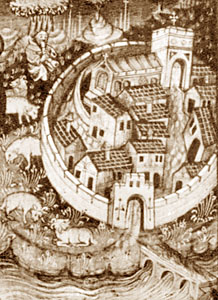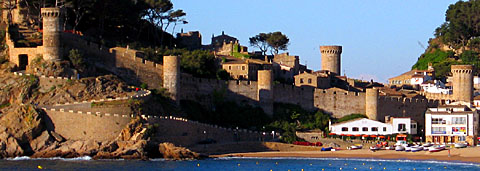|
|
|
|
| |
|
|
The vast majority of the primary sources that bear witness to medieval English towns and the lives of the men and women who resided in them each focus on some particular aspect or event. General descriptions of any individual towns are rare, as are surveys or reviews of English towns generally. We do possess a few examples of these, however, and several are given here. Two happen to be roughly contemporary with each other, from the period when we are just beginning to see boroughs emerging as distinctive entities in the social and economic fabric. Furthermore, they present contrasting viewpoints on urban society: one pro, one con. The third comes at the close of the Middle Ages, while the fourth is a century later yet looks back at a city as it was in the medieval period. A fifth document (actually the fourth in the sequence below) is not in the same mould, but has been included for the light it throws upon key characteristics of towns in medieval England.
Most of the medieval texts presented in the Florilegium Urbanum almost inevitably date from the thirteenth to fifteenth centuries – the final third of what is conventionally considered the European Middle Ages. This is due to a dearth of surviving written documentation produced by urban sources in earlier periods. The main reasons for this dearth, briefly, are: the lack of literacy among the laity; the consequential absence, outside of the Church, of habitual and systematic drafting and preservation of written evidence of events or resources (reliance being placed on memory); and the fact that towns had no self-directed administration of their own to incline towards the development of record-keeping at the local level. It will be noted that all of the earlier documents included in this introductory section of the Florilegium were written by churchmen, most of whom are unlikely to have envisaged their texts ever being read by, and rarely to, laymen. In an effort to redress the chronological bias slightly, and avoid ignoring towns in the Late Anglo-Saxon period, a selection of extracts from even older documents is presented in the first article of the section.
 |
An imaginary town, in idyllic rural setting, with typical features: riverside location; enclosing wall with gates controlling the main entrances/exits; high street, connecting to a bridge across the river; parish church; the square on the left side may even represent a marketplace. From the Book of Hours of Henry Beauchamp, Duke of Warwick (before 1446). |
For the earliest pair of self-conscious descriptions of towns we have two monks to thank – not surprisingly, given the limitations of literacy in that period. They are unlikely to have ever had contact with one another, but each gives us a lively and entertaining perspective on English towns of the late twelfth century. A different viewpoint comes from an outsider, probably a member of a diplomatic embassy sent by Venice to London; to Italian eyes – as well as in comparison to France – England seemed only lightly urbanized, even though to English eyes it might sometimes appear that there were too many small towns competing for a piece of the commercial pie, as indicated in a complaint to parliament (below). The third description of an individual town is from an insider: prominent townsman John Hooker, a member of Exeter's city government. In contrast to FitzStephen's account, which might best fit in a modern library under the subject classification of "Travel", Hooker's description has a more historical bent, and is a precursor to the antiquarian local histories that were to flourish in the eighteenth and nineteenth centuries.
The lesser-known of the two monastic authors, both today and in the Middle Ages, is Richard de Devizes, a monk of St. Swithun's, the priory of Winchester's cathedral. He was presumably born at the place from which derives his surname, a small town in Wiltshire some 35 miles northwest of Winchester and, again presumably as a monk at Winchester throughout his adult life, may well not ever have travelled beyond that part of the country. Nonetheless, Winchester was an important city at that time and attracted visitors from all parts, and Richard doubtless heard news, rumours and opinions about various English towns – many of his criticisms have the tone of put-downs of the type communicated in casual conversation. Richard's brief critique of English towns is outside of the mainstream of the theme of his chronicle, and it reflects both a measure of scorn for urban society that would have been echoed by many monks (except perhaps for those of more worldly tastes) and yet an affection for his own adopted home-town.
The better-known writer is William FitzStephen, who prefaced his biography of Thomas Becket with a description of London during the reign of Henry II. FitzStephen, according to his own claim, served Becket both in the latter's role of chancellor, by preparing legal documents and assisting in the hearing of petitions, and in his role of archbishop, as a chaplain. He likewise claimed to be one of the three clerics who did not desert Becket during his assassination (1170). Despite or perhaps because of this, he seems to have won the favour of Henry II (whom he avoided blaming in his account of the murder), if he is the same William FitzStephen who in 1171 was appointed sheriff of Gloucestershire and later (from 1176) served as an itinerant royal justice; of that identification we cannot be certain. The biography was written at some point in the ten or twelve years following Becket's death.
The reason for a description of London preceding the biography of Becket was, ostensibly, that Becket was – like FitzStephen himself – a Londoner, being the son of Gilbert Becket, a Rouen merchant who settled in London and became an important enough citizen to serve as a sheriff of the city. Yet it is less Becket's association with the city and more FitzStephen's own that comes through in the description, which could easily stand by itself – and so, stripped of the biography, it does in some surviving versions, including one incorporated into London's Liber Custumarum. He provides us with a look at London through rose-tinted glasses, for his remembrances of the city are largely those of exuberant youth, full of wonder at metropolitan life, and eager to enjoy its pleasures. Although he does talk in general terms about aspects of the city, he also focuses on particular places, particular events – doubtless calling up the features that most embedded themselves in his memory.

If one can mentally block out modern intrusions,
glimpses of medieval urban landscapes can still be had,
although sometimes we must look beyond England.
This panorama shows part of the old town of
Tossa
(Spain), encapsulated by its defensive wall.
Photo © J. Patterson.
It is easy to be tempted today, given the relative ease and luxuries of twenty-first century living and working conditions, to view life in medieval towns as dirty, harsh, unpleasant, and short. We must remember that this is only a perspective, albeit one not without some merit. It has an advocate in Richard de Devizes, if in tongue-in-cheek fashion; his harshest words are for London, not only because as England's sole cosmopolitan city it was the biggest den of iniquity, but also because its efforts to create a revolutionary commune in 1191 had filled him with a disgust founded on fear. FitzStephen's perspective is quite different, if naive where Devizes' is cynical; his fondness for London and his high regard for its amenities and its joie de vivre are clear enough. He has little bad to say of London, other than references to its drunks and its vulnerability to fire. His account is a rhapsodic expression of that civic pride which historians must otherwise deduce from more formal or more impersonal echoes.
Yet for all this, and despite some minor flights of rhetoric in which the author tries to display his knowledge of classical authors (a trait common to writers of that time, although the knowledge was often acquired indirectly), FitzStephen's description is credible, as indeed Devizes' chronicle is believed to be, once the satirical elements are taken into account. FitzStephen has not exaggerated for the sake of hyperbole, only for literary effect or on the basis of second-hand information which he accepts unquestioningly. Much of what he speaks about is corroborated from other evidence; the ice jousting, for example, is depicted in a medieval illustration. We can well imagine that he was an eye-witness to most of what he portrays, as well as a participant in the schoolboy debating contests he recounts with some enthusiasm. The description ranges from the macrocosm of the quality of the citizens to the microcosm of the cookshop on the quayside and the Smithfield horse-races, which surely reflect fond memories of the author himself. The popularity of fast-food and racetracks is no modern phenomenon.

This late 15th century woodcut shows skaters
engaged
in the kinds of activities
described by FitzStephen.
There is a good deal we can recognize in FitzStephen's characterization of twelfth-century London society that rings true for city life in the twentieth century, while Devizes' account similarly reflects many of today's prejudices towards the urban setting. Plus ça change...
This introductory section concludes, with its final set of documents, where some might have expected it to begin: with a little historiography. Historical and philosophical extracts are presented to illustrate a discussion aiming to get some sense of to what extent the more literate members of medieval society were conscious of, or interested in, urban history or their perceived local or personal heritage.
A critique of English towns in the twelfth century
A perspective on English towns in the fifteenth century
Exeter at the close of the Middle Ages
Urban origins and local history in medieval perception
Introduction | Community | Economy | Government | Lifecycle | thesaurus
|
|
 main menu |
|
|
|
|||